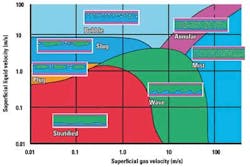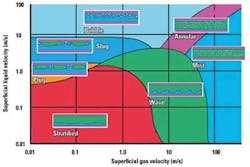Multi-phase meter advances improve flow assurance mitigation
Emmelyn Graham
NEL
Flow assurance issues include the formation of hydrates, waxes, scaling, slugging, chemical deposits, erosion, and corrosion. Failure to quickly identify and mitigate these problems can cause serious damage to equipment, and have catastrophic consequences in terms of safety, production, and reduced revenue.
Multi-phase meter advantages
In offshore pipe systems, the flow is predominately multi-phase and consists of a mixture of oil, gas, and water in varying proportions. Different multi-phase flow regimes can form where the oil, gas, and water phases are disturbed in the pipeline, depending on the flow conditions and pipe configurations. Industry is trending toward the use of multi-phase meters due to advantages such as reduced capex and opex; increased capability to monitor individual wells in real time; reduction in the need for test separators and their maintenance; and minimal loss of production through well shutdowns during tests.
Combatting slugging
Slugging is one of the multi-phase flow regimes that can cause major operational problems. It causes equipment and pipeline fatigue and failure due to the fluctuating pressure, forces, and mechanical loads. In the worst cases, this can result in potential loss of containment, which can be difficult to identify subsea and cause significant environmental implications. Identifying and controlling slug flow can therefore improve production rates and overall system reliability and performance. However, the conditions to generate slugging depend on the pressure, gas-liquid volume fractions, velocity of fluids, and pipe configuration. Also, the frequency of liquid slugs can significantly vary from sub-second to an hour or more, making detection difficult. Even with single-phase flows, pressure surges from rapid changes in fluid velocity can cause unbalanced loads within pipeline systems, leading to fatigue.
Prediction of multi-phase flow regimes is critical for mitigating the potential issues from the formation of slug flow, however this is extremely difficult. While there are general flow regimes maps available, these only give an indication of likely flow structure and are usually developed for certain conditions and cannot be extrapolated easily. Consequently, NEL is leading a large multi-phase research collaboration. Part of the European Metrology Research Program, it aims to develop and validate new multi-phase flow regime maps.
The Research Partnership to Secure Energy for America (RPSEA) organization is developing and testing a subsea clamp-on multi-phase meter that can be used to identify the frequency of slugging. Part of the RPSEA project involved using NEL's proprietary physical property generator to assess thermodynamic flow assurance issues on subsea sampling equipment design.
Subsea risks
Industry is developing deepwater wells and using longer subsea tiebacks. These advances have made mitigating flow assurance issues more costly and challenging due to the reduced accessibility and distances involved. Flow assurance strategies and new techniques that can cost-effectively predict and prevent issues are essential, especially when oil prices are so low, to ensure efficient extraction and transportation of oil to guarantee maximum recovery and revenue.
Multi-phase meters can assist with identifying and mitigating flow assurance risks. For example, subsea multi-phase meters can immediately detect the onset of water and the quantity flowing. This enables the rapid mitigation of hydration production and can also be used to determine the correct dosing of expensive hydrate and corrosion inhibitors. Some meters also incorporate salinity probes to improve the accuracy of the meter and provide information on the type of water present for improved reservoir management.
New multi-phase meter advances include the ability to detect scale on the pipe wall and the measurement of the scale thickness. This can be used to alert operators to take corrective actions or to monitor further build-up.
In the future, tomography-type devices will form part of a suite of tools used to guarantee subsea flow assurance. They are currently being developed for topsides and subsea applications to determine the flow regimes and enable more effective management and design of production systems to reduce multi-phase flow issues.
Flow assurance challenges
Flow assurance issues can cause serious damage, impact the integrity of equipment, and reduce production. Operators are therefore keen to use tried-and-tested equipment and techniques to predict, prevent, and manage flow assurance risks. However, as many laboratory facilities operate at low pressure and do not provide realistic conditions, validation and research and development is limited to mimicking subsea conditions for multi-phase testing. Large-scale high-pressure multi-phase flow facilities are essential to mimic these subsea flow conditions to realistically test meters, tomography and other components. This will ensure safety, reliability, and improve confidence in flow assurance techniques and strategies.

